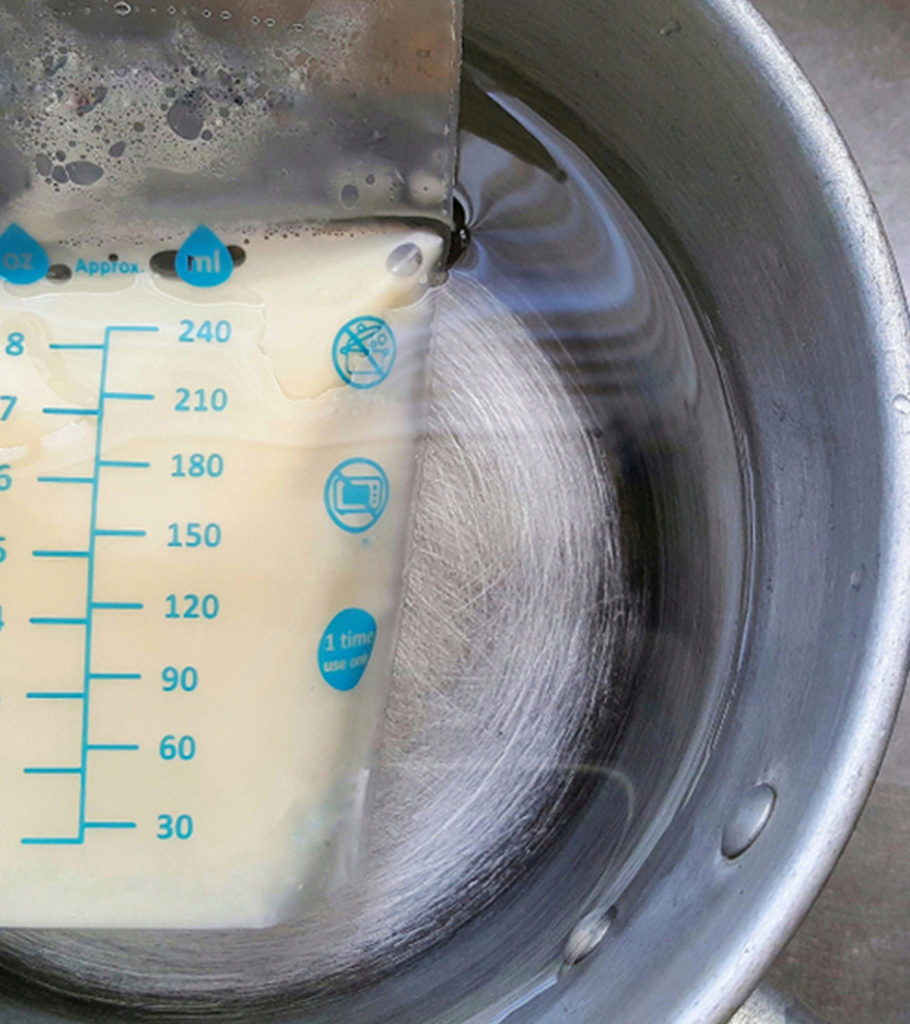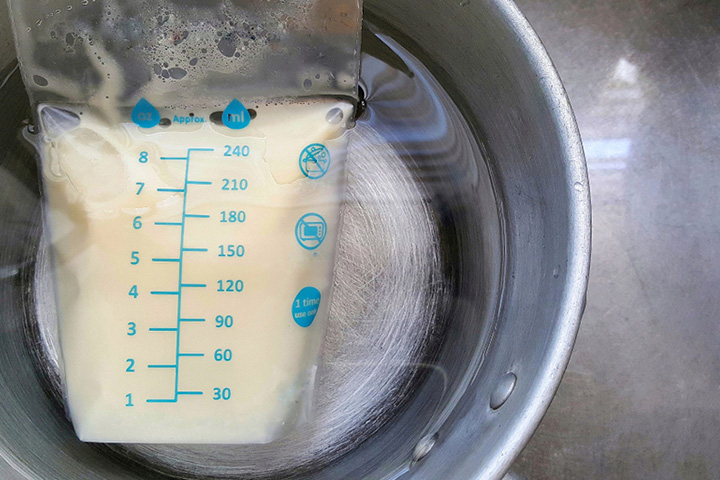Image: Shutterstock
According to the Centers for Disease Control and Prevention (CDC), breast milk doesn’t require heating. One can feed room temperature or cold breast milk to their baby (1). Yet, several parents prefer warming refrigerated or frozen breast milk mainly for two common reasons.
Firstly, warming stored breast milk helps to mix fat layers that tend to separate during storage. Secondly, some babies like consuming warm milk rather than cold, so warming milk in such cases becomes necessary. Thus, knowing the safe ways to warm breast milk can be helpful for parents feeding stored breast milk to their babies.
This post tells you about the methods and ideal temperature to warm stored breast milk and precautions to take while warming milk.
What Is The Ideal Temperature To Warm Milk?
Experts suggest putting the milk bottle or milk storage bag in lukewarm water (98.6°F to 104°F or 37°C to 40°C) for a few minutes. The ideal time would be 20 minutes for warming thawed milk (2). Alternatively, you can use a bottle warmer to warm up the milk. But if you do so, ensure the temperature does not exceed 104°F (40°C).
The milk should feel lukewarm or comfortably warm to the touch. Avoid overheating breast milk since it alters its nutritional and immunological properties (3). In case you accidentally overheat breast milk, you can still cool it down and feed the baby.
Different Ways To Warm Breast Milk
Here are some methods to warm refrigerated or frozen milk (1) (4).
1. Warm running water: Place a tightly-sealed bag or bottle of breast milk directly under a running tap for a few minutes until the bottle starts feeling warm. Ensure the tap water is warm or lukewarm but not hot. Once you reach the desired temperature, swirl (not shake) the bottle or bag to mix the fat layers. Although the method looks quick, it wastes a lot of water, and holding the bottle under the tap for long may not be comfortable.
2. Warm water bath: Heat water in a pan or bowl to 98.6°F to 104°F (37°C to 40°C) and then switch off the heat. Place tightly-sealed milk bottle or bag into the bowl/pan for a few minutes until it feels warm to touch. Once the milk container feels warm, take it out, and swirl. Check milk’s temperature by dropping a few drops at the back of your hand or on your wrist. The milk must feel neutral or slightly warm but not hot.
3. Bottle warmer: A bottle warmer is a convenient electrical appliance to warm breast milk. You need to place a milk bottle in the warmer and select the desired warming setting. The milk is warm and ready to feed within a minute to three minutes. However, overheating is a concern that often arises with bottle warmers, so reading the user instruction manual before use is necessary.
Additionally, keep a food thermometer handy to check the milk temperature before feeding it to the baby.
You can use the same methods to warm frozen milk, but you need to thaw the milk before warming. You can thaw frozen milk in several ways, such as thawing in the refrigerator or putting the milk bottle or bag under warm running water (1).
What Not To Do While Warming Breast Milk?
Warming breast milk at the right temperature and for the appropriate duration is imperative to maintain breast milk quality. Here are some don’ts that you need to follow.
1. Don’t use boiling hot water to warm the milk. Using hot water overheats the breast milk, changing the milk’s composition. It destroys heat-sensitive nutrients, such as folate, fat, enzymes, and beneficial probiotics (5) (6) (7). It also breaks down and inactivates milk’s bioactive proteins (3). Loss of these key components may affect the baby’s total nutritional intake, affecting their overall health over time.
2. Never heat breast milk directly on the stove. You should never pour the breast milk into a pan or bowl and heat it over the flame. Doing so exposes the milk to high heat that does extensive damage to the milk’s composition. Besides, it could increase the risk of bacterial contamination of breast milk.
3. Don’t microwave breast milk. The microwave generates high heat that alters breast milk’s nutritional composition and degrades its anti-infective properties. Besides, the milk heats unevenly in a microwave, creating hot spots that can scald your baby’s mouth and throat (8) (9). Additionally, placing ordinary plastic bottles in the microwave could cause BPA and phthalates to leak into the milk (10). It is why experts recommend using BPA-free plastic bottles to store milk (11).
It is essential to follow the right method to warm breast milk, like how it is important to choose an appropriate breast milk storage method. You may consult your lactation consultant or healthcare provider to clear your doubts.
How Long Can Heated Breast Milk Stay Outside?
You must feed breast milk to your baby as soon as you warm it. If the baby isn’t ready to feed, the milk can stay outside for one to two hours. Throw away any leftover breast milk after it has stayed at room temperature for over two hours (1).
Do not refreeze or reheat/rewarm the milk that has already been heated once. Doing so could deteriorate milk’s quality. It could also expose the baby to germs that might have contaminated the milk while it was outside.
Breast milk is the primary source of nutrition for babies. Feed freshly expressed breast milk whenever possible. Store expressed milk properly and warm it appropriately. When milk is heated correctly, it conserves its nutritional value. Therefore, warming breast milk to the right temperature and appropriate duration is imperative for the baby’s nourishment.

